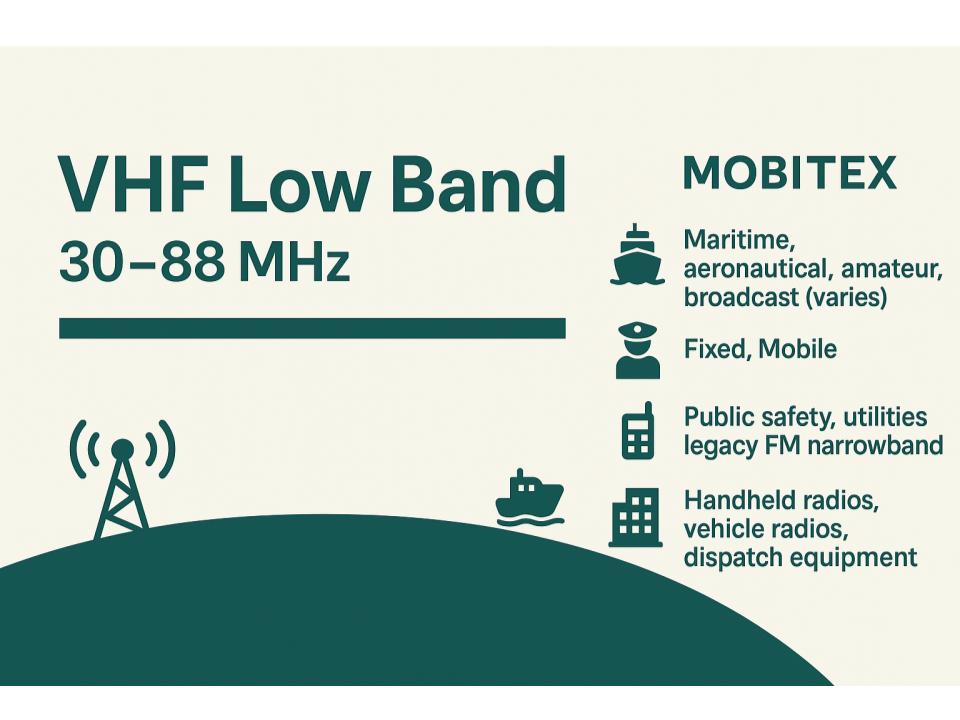Frequency
51 MHz
Range
50–54 MHz
Band Group
VHF (30–300 MHz)
🌐 Summary
51 MHz: 6 m Amateur (50–54 MHz); Amateur radios
Within the 6 m amateur band (50–54 MHz); DX via sporadic‑E/TEP during solar peaks.

🔍 Explore the full RF Spectrum database
📡 Band & Geometry key
| Field | Value |
|---|---|
| Wavelength (m) | 5.882 |
| Waveforms | – |
| Antenna Form Factor (Typical) | ¼-wave ≈ 147 cm |
| Band Family | Amateur/CB |
| Band | 6 m Amateur Band |
| Primary Common Name | 6 m Amateur Band |
| FSPL @ 1 km [dB] | 66.591403521959 |
| FSPL @ 10 km [dB] | 86.591403521959 |
| Fresnel Radius @ 1 km (m) | 38.347124543886 |
| Band Group | VHF (30–300 MHz) |
| Tax Band Family | VHF |
| Tax Band Class | VHF Low (30–88) |
🧩 Applications & Usage
| Field | Value |
|---|---|
| Primary Application | – |
| Lower Neighbor Use | Land mobile / Fixed (VHF low) |
| Upper Neighbor Use | Broadcasting (legacy TV) |
| Typical Services Devices | 6 m Amateur (50–54 MHz) |
| Market Common Devices | Amateur radios |
| Refarming Use | No |
| Device Ecosystem Size | Medium |
| Device Hotspots (MHz) | 51 |
| Device Category | Amateur Radio Equipment |
| Typical Use Cases | – |
| Modulation (Device) | Varies by device |
| Channel Width (Device) [kHz] | Varies |
| Device Region Profiles | Varies by country / allocation |
| Per-Region EIRP Or Duty (Device) | Varies by regulation |
| Allocation Relevance (Device) | Medium |
| Adjacent-Band Collision Risks (Device) | Low–Moderate |
| Example Devices Or Skus | Amateur Radio (6m Band) |
| Common Protocols | Amateur (various modes) |
🗒️ Notes
| Field | Value |
|---|---|
| Receiver Selectivity Notes | – |
| Interference Notes | Propagation sensitive; adjacent land-mobile allocations regionally |
| Compatibility Risk Notes | – |
| Notes | Within the 6 m amateur band (50–54 MHz); DX via sporadic‑E/TEP during solar peaks. |
| Propagation Notes | Strong coverage, good indoor penetration |
⚙️ Technical Rules
| Field | Value |
|---|---|
| Lower Band Frequency Limit | 50 |
| Upper Band Frequency Limit | 54 |
| EIRP Indoor Limits | N/A (licensed; verify national rules) |
| EIRP Outdoor Limits | N/A (licensed; verify national rules) |
| PSD Limit | — |
| Emission Mask Class | Generic (planning) |
| Guardband Minimum [kHz] | 100 |
| Typical Bandwidths | 2.7 kHz SSB, 12.5 kHz FM |
| Autocalculated Bandlimits | No |
| Typical Bandwidths (Estimated) | 2.7 kHz SSB, 12.5 kHz FM |
| Max EIRP [dBm] | Varies by regulation |
| Power Source Or Duty Profile (Typical) | – |
| Channelization Plan | – |
| Channelization | – |
| Guard Band Requirement | – |
| OOB Emission Limit [dBm/MHz] | -13 (baseline) |
| Spurious Emission Limit (dBm) | -30 (baseline) |
| RX Blocking Min [dBm] | -15 (planning) |
| Duplexing | Half-duplex |
| Duplexing Information | Simplex/repeaters |
| Uplink Pairing | – |
| Downlink Pairing | – |
| Paired Band Info | – |
| Max EIRP [dBm] | – |
| Channelization Block Size | Varies (CW/SSB segments) |
| 3GPP Band Number | |
| Example 3GPP Bands | – |
| LTE Uplink Bands | – |
| LTE Downlink Bands | – |
| NR Uplink Bands | – |
| NR Downlink Bands | – |
| Guard Bands | Voluntary |
| Protocol Or Standard | – |
🌎 Country Overrides
| Field | Value |
|---|---|
| Post Status | publish |
| Tax Service Category | Other / Various |
| Tax License Type | Amateur (Licensed) |
| Tax Regions | Global / Varies |
| ITU Region 1 | Amateur |
| ITU Region 2 | Amateur |
| ITU Region 3 | Amateur |
| License Type | Amateur service (individual license; some bands secondary) |
| Primary Application | – |
| Primary Services | – |
| Spurious Emission [dBm] | -30 (baseline) |
| Lower Neighbor Use | Land mobile / Fixed (VHF low) |
| Upper Neighbor Use | Broadcasting (legacy TV) |
| Licensing Model | Licensed (Amateur) |
| Typical Services Devices | 6 m Amateur (50–54 MHz) |
| US FCC Alloc | Amateur 6 m (Part 97)– |
| CA IC Alloc | Amateur 6 m– |
| UK Ofcom Alloc | Amateur 6 m– |
| US Ref | – |
| Typical Bandwidths | 2.7 kHz SSB, 12.5 kHz FM |
| Market Licensing Model | Licensed (Amateur) |
| Market Common Devices | Amateur radios |
| Fresnel Radius (1st, 1 km) [m] | 38.347124543886 |
| Typical Bandwidths (Estimated) | 2.7 kHz SSB, 12.5 kHz FM |
| Auction Status | – |
| Refarming Use | No |
| Typical Site Spacing km | – / – |
| Device Ecosystem Size | Medium |
| Traffic Load Share | Coverage-heavy, low capacity share |
| Device Hotspots (MHz) | 51 |
| Device Category | Amateur Radio Equipment |
| Typical Use Cases | – |
| Typical Center Frequencies [MHz] | – |
| Rule Part (Fcc Or Region) | – |
| Modulation (Device) | Varies by device |
| Channel Width (Device) [kHz] | Varies |
| Device Region Profiles | Varies by country / allocation |
| Per-Region EIRP Or Duty (Device) | Varies by regulation |
| Allocation Relevance (Device) | Medium |
| Adjacent-Band Collision Risks (Device) | Low–Moderate |
| Example Devices Or Skus | Amateur Radio (6m Band) |
| Antenna Form Factor (Typical) | ¼-wave ≈ 147 cm |
| Power Source Or Duty Profile (Typical) | – |
🛡️ Regulatory & Neighbors
| Field | Value |
|---|---|
| Lower Band Frequency Limit | 50 |
| Upper Band Frequency Limit | 54 |
| Rx Blocking Min dBm | -15 (planning) |
| Lower Neighbor Use | Land mobile / Fixed (VHF low) |
| Upper Neighbor Use | Broadcasting (legacy TV) |
| Lower Neighbor Band | Land mobile / Fixed (VHF low) |
| Lower Neighbor Range | 31.000–49.000 MHz |
| Upper Neighbor Label | Broadcasting (legacy TV) |
| Upper Neighbor Range | 55.000–71.000 MHz |
| Adjacent-Band Collision Risks (Device) | Low–Moderate |
| Real-World Range (Indoor/Outdoor) | – |
| US FCC Alloc | Amateur 6 m (Part 97)Amateur 6 m (Part 97) |
| CA IC Alloc | Amateur 6 mAmateur 6 m |
| UK Ofcom Alloc | Amateur 6 mAmateur 6 m |
| Regulatory References | US: -; CA: -; UK: – |
| Global Harmonization | Global |
| Crossborder Coordination | High |
| Sharing Mechanism | – |
| Auction Status | – |
| Guard Or Pair | – |
📈 Market & Measurements
| Field | Value |
|---|---|
| Noise Floor | -105 dBm (est.) |
| Interference Cases | – |
| Lower Neighbor Range | 31.000–49.000 MHz |
| Upper Neighbor Range | 55.000–71.000 MHz |
| Interference Notes | Propagation sensitive; adjacent land-mobile allocations regionally |
| Market Licensing Model | Licensed (Amateur) |
| Market Commercial Value | Specialized |
| Market Common Devices | Amateur radios |
| Market Deployment Density | Low (hobbyist) |
| Noise Floor (Estimated) | -105 dBm (est.) |
| Market Commercial Value (Estimated) | Specialized |
| Ecosystem Maturity | Emerging |
| Indoor Penetration | Good |
| Known Interference | No major interference issues noted |
| Device Ecosystem Size | Medium |
| Real-World Range (Indoor/Outdoor) | – |
| Antenna Form Factor (Typical) | ¼-wave ≈ 147 cm |
| Ecosystem Maturity | Emerging |
| Device Ecosystem Size | Medium |
| Chipset Availability | Limited / TBD |
| Operator Deployments | Limited operators |
| Technology Generations Deployed | Multiple / TBD |
| Roaming Support | – |
| Traffic Load Share | Coverage-heavy, low capacity share |
| Indoor Penetration | Good |
| Known Interference | No major interference issues noted |
| Occupancy | Medium |
| Occupancy Bucket Pct | 10–30% |
| Latency Profile | – |
| Common Channels Or Profiles | – |
| Security Features | – |
| Lbt Or Fhss Requirement | – |
| Popularity (Installed Base) | – |
| Coexistence Tips | – |
| Latency Class | – |
| Device Hotspots (Scoped && Tagged) | – |

